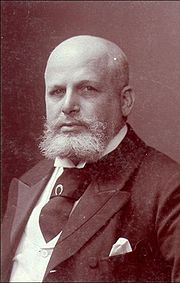
Oskar Lassar
Encyclopedia

Hamburg
-History:The first historic name for the city was, according to Claudius Ptolemy's reports, Treva.But the city takes its modern name, Hamburg, from the first permanent building on the site, a castle whose construction was ordered by the Emperor Charlemagne in AD 808...
. After earning his medical doctorate in 1872, he was briefly a hospital assistant at the Berlin
Berlin
Berlin is the capital city of Germany and is one of the 16 states of Germany. With a population of 3.45 million people, Berlin is Germany's largest city. It is the second most populous city proper and the seventh most populous urban area in the European Union...
Charité
Charité
The Charité - Universitätsmedizin Berlin is the medical school for both the Humboldt University and the Free University of Berlin. After the merger with their fourth campus in 2003, the Charité is one of the largest university hospitals in Europe....
. Afterwards he started a private hospital for dermatology and syphilis
Syphilis
Syphilis is a sexually transmitted infection caused by the spirochete bacterium Treponema pallidum subspecies pallidum. The primary route of transmission is through sexual contact; however, it may also be transmitted from mother to fetus during pregnancy or at birth, resulting in congenital syphilis...
in Berlin. His clinic was known for being technologically advanced, and it was the first to have a Finsen ultraviolet light therapy
Light therapy
Light therapy or phototherapy consists of exposure to daylight or to specific wavelengths of light using lasers, light-emitting diodes, fluorescent lamps, dichroic lamps or very bright, full-spectrum light, usually controlled with various devices...
device and X-ray machine. Lassar was also the first to assemble a collection of moulage in Germany. In 1902 he became a professor at the University of Berlin.
Oskar Lassar is remembered for the creation of public bath house
Public bathing
Public baths originated from a communal need for cleanliness. The term public may confuse some people, as some types of public baths are restricted depending on membership, gender, religious affiliation, or other reasons. As societies have changed, public baths have been replaced as private bathing...
s for low-income individuals in Germany and Austria. These bath houses were constructed in the interest of public hygiene
Hygiene
Hygiene refers to the set of practices perceived by a community to be associated with the preservation of health and healthy living. While in modern medical sciences there is a set of standards of hygiene recommended for different situations, what is considered hygienic or not can vary between...
, at a time when poorer people didn't have private baths or showers. In Germany the bath-houses were called Volksbad, and in Austria, Tröpferlbad. In 1899, Lassar was founder of the German Society for Volksbädern. One of his slogans was "a weekly bath for every German."
He was very social, and he invited physicians who made referrals to his clinic to a champagne breakfast twice a year.
Lassar was one of the first physicians in Europe to use the recently discovered X-ray
X-ray
X-radiation is a form of electromagnetic radiation. X-rays have a wavelength in the range of 0.01 to 10 nanometers, corresponding to frequencies in the range 30 petahertz to 30 exahertz and energies in the range 120 eV to 120 keV. They are shorter in wavelength than UV rays and longer than gamma...
technology for therapeutic purposes. He also developed a zinc
Zinc
Zinc , or spelter , is a metallic chemical element; it has the symbol Zn and atomic number 30. It is the first element in group 12 of the periodic table. Zinc is, in some respects, chemically similar to magnesium, because its ion is of similar size and its only common oxidation state is +2...
paste for treatment of eczema
Eczema
Eczema is a form of dermatitis, or inflammation of the epidermis . In England, an estimated 5.7 million or about one in every nine people have been diagnosed with the disease by a clinician at some point in their lives.The term eczema is broadly applied to a range of persistent skin conditions...
, which is still used today and known as Lassar's paste. He was founder of the dermatology journal Dermatologische Zeitschrift and was its editor from 1893 until his death in 1907.
Selected writings
- Volksgesundheit und menschliche Gesellschaft in ihren Wechselbeziehungen (Public Health and Human Society) (1892) (Health Consequences concerning Prostitution)
- Geschichten und Gedichte für kleine Kinder (Stories and Poems for Small Children) (1895) (The "people" bath) (About Home Healthcare)

